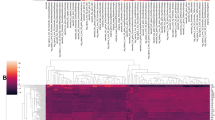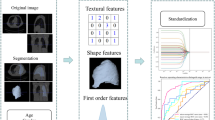Abstract
Objectives
To analyze whether CT image normalization can improve 3-year recurrence-free survival (RFS) prediction performance in patients with non-small cell lung cancer (NSCLC) relative to the use of unnormalized CT images.
Methods
A total of 106 patients with NSCLC were included in the training set. For each patient, 851 radiomic features were extracted from the normalized and the unnormalized CT images, respectively. After the feature selection, random forest models were constructed with selected radiomic features and clinical features. The models were then externally validated in the test set consisting of 79 patients with NSCLC.
Results
The model using normalized CT images yielded better performance than the model using unnormalized CT images (with an area under the receiver operating characteristic curve of 0.802 vs 0.702, p = 0.01), with the model performing especially well among patients with adenocarcinoma (with an area under the receiver operating characteristic curve of 0.880 vs 0.720, p < 0.01).
Conclusions
CT image normalization may improve prediction performance among patients with NSCLC, especially for patients with adenocarcinoma.
Key Points
• After CT image normalization, more radiomic features were able to be identified.
• Prognostic performance in patients was improved significantly after CT image normalization compared with before the CT image normalization.
• The improvement in prognostic performance following CT image normalization was superior in patients with adenocarcinoma.






Similar content being viewed by others
Abbreviations
- AC:
-
Adenocarcinoma
- AUC:
-
Area under the receiver operating characteristic curve
- CT:
-
Computed tomography
- GGO:
-
Ground-glass opacity
- GLCM:
-
Gray level co-occurrence matrix
- GLSZM:
-
Gray level size zone matrix
- HR:
-
Hazard ratio
- NSCLC:
-
Non-small cell lung cancer
- RF:
-
Random forest
- SqCC:
-
Squamous cell carcinoma
- TNM:
-
Tumor-node-metastasis
References
Siegel RL, Miller KD, Jemal A (2019) Cancer statistics, 2019. CA Cancer J Clin 69:7–34. https://doi.org/10.3322/caac.21551
Crosbie PA, Shah R, Summers Y, Dive C, Blackhall F (2013) Prognostic and predictive biomarkers in early stage NSCLC: CTCs and serum/plasma markers. Transl Lung Cancer Res 2:382. https://doi.org/10.3978/j.issn.2218-6751.2013.09.02
Detterbeck FC, Boffa DJ, Tanoue LT (2009) The new lung cancer staging system. Chest 136:260–271. https://doi.org/10.1378/chest.08-0978
Lee SY, Jung DK, Choi JE et al (2017) Functional polymorphisms in PD-L1 gene are associated with the prognosis of patients with early stage non-small cell lung cancer. Gene 599:28–35. https://doi.org/10.1016/j.gene.2016.11.007
Lee SY, Jin CC, Choi JE et al (2016) Genetic polymorphisms in glycolytic pathway are associated with the prognosis of patients with early stage non-small cell lung cancer. Sci Rep 6:35603. https://doi.org/10.1038/srep35603
Aoki T, Hanamiya M, Uramoto H, Hisaoka M, Yamashita Y, Korogi Y (2012) Adenocarcinomas with predominant ground-glass opacity: correlation of morphology and molecular biomarkers. Radiology 264:590–596. https://doi.org/10.1148/radiol.12111337
Lee HY, Lee SW, Lee KS et al (2015) Role of CT and PET imaging in predicting tumor recurrence and survival in patients with lung adenocarcinoma: a comparison with the International Association for the Study of Lung Cancer/American Thoracic Society/European Respiratory Society Classification of Lung Adenocarcinoma. J Thorac Oncol 10:1785–1794. https://doi.org/10.1097/JTO.0000000000000689
Aerts HJWL, Velazquez ER, Leijenaar RT et al (2014) Decoding tumour phenotype by noninvasive imaging using a quantitative radiomics approach. Nat Commun 5:1–9. https://doi.org/10.1038/ncomms5006
Liu Z, Wang S, Dong D et al (2019) The applications of radiomics in precision diagnosis and treatment of oncology: opportunities and challenges. Theranostics 9:1303. https://doi.org/10.7150/thno.30309
Oh D, Kim S, Park D et al (2018) Correction of severe beam-hardening artifacts via a high-order linearization function using a prior-image-based parameter selection method. Med Phys 45:4133–4144. https://doi.org/10.1002/mp.13072
Kim Y, Oh D, Hwang D (2017) Small-scale noise-like moiré pattern caused by detector sensitivity inhomogeneity in computed tomography. Opt Express 25:27127–27145. https://doi.org/10.1364/OE.25.027127
Kim Y, Baek J, Hwang D (2014) Ring artifact correction using detector line-ratios in computed tomography. Opt Express 22:13380–13392. https://doi.org/10.1364/OE.22.013380
Eo T, Jun Y, Kim T, Jang J, Lee HJ, Hwang D (2018) KIKI-net: cross-domain convolutional neural networks for reconstructing undersampled magnetic resonance images. Magn Reson Med 80:2188–2201. https://doi.org/10.1002/mrm.27201
Eo T, Shin H, Jun Y, Kim T, Hwang D (2020) Accelerating Cartesian MRI by domain-transform manifold learning in phase-encoding direction. Med Image Anal 63:101689. https://doi.org/10.1016/j.media.2020.101689
Shafiq-ul-Hassan M, Latifi K, Zhang G, Ullah G, Gillies R, Moros E (2018) Voxel size and gray level normalization of CT radiomic features in lung cancer. Sci Rep 8:1–9. https://doi.org/10.1038/s41598-018-28895-9
Traverso A, Wee L, Dekker A, Gillies R (2018) Repeatability and reproducibility of radiomic features: a systematic review. Int J Radiat Oncol Biol Phys 102:1143–1158. https://doi.org/10.1016/j.ijrobp.2018.05.053
Choe J, Lee S, Do K et al (2019) Deep learning–based image conversion of CT reconstruction kernels improves radiomics reproducibility for pulmonary nodules or masses. Radiology 292:365–373. https://doi.org/10.1148/radiol.2019181960
Berenguer R, Pastor-Juan MR, Canales-Vázquez J et al (2018) Radiomics of CT features may be nonreproducible and redundant: influence of CT acquisition parameters. Radiology 288:407–415. https://doi.org/10.1148/radiol.2018172361
Orlhac F, Frouin F, Nioche C, Ayache N, Buvat I (2019) Validation of a method to compensate multicenter effects affecting CT radiomics. Radiology 291:53–59. https://doi.org/10.1148/radiol.2019182023
Park BW, Kim JK, Heo C, Park KJ (2020) Reliability of CT radiomic features reflecting tumour heterogeneity according to image quality and image processing parameters. Sci Rep 10:1–13. https://doi.org/10.1038/s41598-020-60868-9
Kawase A, Yoshida J, Ishii G et al (2011) Differences between squamous cell carcinoma and adenocarcinoma of the lung: are adenocarcinoma and squamous cell carcinoma prognostically equal? Jpn J Clin Oncol 42:189–195. https://doi.org/10.1093/jjco/hyr188
Gallardo-Estrella L, Lynch DA, Prokop M et al (2016) Normalizing computed tomography data reconstructed with different filter kernels: effect on emphysema quantification. Eur Radiol 26:478–486. https://doi.org/10.1007/s00330-015-3824-y
Fedorov A, Beichel R, Kalpathy-Cramer J et al (2012) 3D Slicer as an image computing platform for the Quantitative Imaging Network. Magn Reson Imaging 30:1323–1341. https://doi.org/10.1016/j.mri.2012.05.001
Griethuysen JJ, Fedorov A, Parmar C et al (2017) Computational radiomics system to decode the radiographic phenotype. Cancer Res 77:e104–e107. https://doi.org/10.1158/0008-5472.CAN-17-0339
Parmar C, Velazquez ER, Leijenaar R et al (2014) Robust radiomics feature quantification using semiautomatic volumetric segmentation. PLoS One 9:e102107. https://doi.org/10.1371/journal.pone.0102107
Owens CA, Peterson CB, Tang C et al (2018) Lung tumor segmentation methods: impact on the uncertainty of radiomics features for non-small cell lung cancer. PLoS One 13:e0205003. https://doi.org/10.1371/journal.pone.0205003
Kim S, Bae WC, Masuda K, Chung CB, Hwang D (2018) Fine-grain segmentation of the intervertebral discs from MR spine images using deep convolutional neural networks: BSU-Net. Appl Sci Basel 8:1656. https://doi.org/10.3390/app8091656
Kim S, Bae WC, Masuda K, Chung CB, Hwang D (2018) Semi-automatic segmentation of vertebral bodies in MR images of human lumbar spines. Appl Sci Basel 8:1586. https://doi.org/10.3390/app8091586
Zhao B, James LP, Moskowitz CS et al (2009) Evaluating variability in tumor measurements from same-day repeat CT scans of patients with non–small cell lung cancer. Radiology 252:263–272. https://doi.org/10.1148/radiol.2522081593
Parmar C, Grossmann P, Bussink J, Lambin P, Aerts HJWL (2015) Machine learning methods for quantitative radiomic biomarkers. Sci Rep 5:13087. https://doi.org/10.1038/srep13087
Mann HB, Whitney DR (1947) On a test of whether one of two random variables is stochastically larger than the other. Ann Math Stat 18:50–60
Woodard GA, Jones KD, Jablons DM (2016) Lung cancer staging and prognosis. Lung Cancer 170:47–75. https://doi.org/10.1007/978-3-319-40389-2_3
Breiman L (2001) Random forests. Mach Learn 45:5–32. https://doi.org/10.1023/A:1010933404324
DeLong ER, DeLong DM, Clarke-Pearson DL (1988) Comparing the areas under two or more correlated receiver operating characteristic curves: a nonparametric approach. Biometrics 44:837–845. https://doi.org/10.2307/2531595
Kaplan EL, Meier P (1958) Nonparametric estimation from incomplete observations. J Am Stat Assoc 53:457–481. https://doi.org/10.1080/01621459.1958.10501452
Cox DR (1972) Regression models and life-tables. J R Stat Soc Ser B Stat Methodol 34:187–202. https://doi.org/10.1111/j.2517-6161.1972.tb00899.x
Mantel N (1966) Evaluation of survival data and two new rank order statistics arising in its consideration. Cancer Chemother Rep 50:163–170
Clausi DA (2002) An analysis of co-occurrence texture statistics as a function of grey level quantization. Can Aeronaut Space J 28:45–62. https://doi.org/10.5589/m02-004
Moon Y, Sung SW, Moon SW, Park JK (2016) Risk factors for recurrence after sublobar resection in patients with small (2 cm or less) non-small cell lung cancer presenting as a solid-predominant tumor on chest computed tomography. J Thorac Dis 8:2018. https://doi.org/10.21037/jtd.2016.07.90
Hattori A, Matsunaga T, Takamochi K, Oh S, Suzuki K (2017) Importance of ground glass opacity component in clinical stage IA radiologic invasive lung cancer. Ann Thorac Surg 104:313–320. https://doi.org/10.1016/j.athoracsur.2017.01.076
Bakr S, Gevaert O, Echegaray S et al (2018) A radiogenomic dataset of non-small cell lung cancer. Sci Data 5:1–9. https://doi.org/10.1038/sdata.2018.202
Zwanenburg A, Leger S, Vallières M, Löck S (2016) Image biomarker standardisation initiative. arXiv 1612:07003. https://doi.org/10.48550/arXiv.1612.07003
Lambin P, Leijenaar RT, Deist TM et al (2017) Radiomics: the bridge between medical imaging and personalized medicine. Nat Rev Clin Oncol 14:749–762. https://doi.org/10.1038/nrclinonc.2017.141
Chen Q, Zhang L, Mo X et al (2021) Current status and quality of radiomic studies for predicting immunotherapy response and outcome in patients with non-small cell lung cancer: a systematic review and meta-analysis. Eur J Nucl Med Mol Imaging 49:345–360. https://doi.org/10.1007/s00259-021-05509-7
Acknowledgements
This research was supported by D&P BIOTECH Inc. and partially supported by the Yonsei Signature Research Cluster Program of 2022 (2022-22-0002), the KIST Institutional Program(Project No.2E31051-21-204), the Institute of Information and Communications Technology Planning and Evaluation (IITP) Grant funded by the Korean Government (MSIT) Artificial Intelligence Graduate School Program, Yonsei University (2020-0-01361), and the Graduate School of YONSEI University Research Scholarship Grants in 2018. The authors sincerely thank In Yong Park for his diligent proofreading of this paper.
Funding
This research was funded by D&P BIOTECH Inc.
Author information
Authors and Affiliations
Corresponding author
Ethics declarations
Guarantor
The scientific guarantor of this publication is Prof. Dosik Hwang.
Conflict of interest
The authors of this manuscript declare relationships with the following companies: D&P BIOTECH Inc. Mr. Park, Mr. Oh, Dr. Lee, Dr. Jun, and Dr. Hwang have a patent “METHOD FOR PREDICTING PROGNOSIS IN CANCER PATIENT USING CLINICAL INFORMATION AND RADIOMIC FEATURE” pending. Dr. Shin and Dr. Lee have nothing to disclose.
Statistics and biometry
One of the authors has significant statistical expertise.
Informed consent
Written informed consent was waived by the Institutional Review Board.
Ethical approval
Institutional Review Board approval was obtained.
Methodology
• retrospective
• diagnostic or prognostic study
• multicenter study
Additional information
Publisher’s note
Springer Nature remains neutral with regard to jurisdictional claims in published maps and institutional affiliations.
Supplementary Information
ESM 1
(DOCX 7829 kb)
Rights and permissions
About this article
Cite this article
Park, D., Oh, D., Lee, M. et al. Importance of CT image normalization in radiomics analysis: prediction of 3-year recurrence-free survival in non-small cell lung cancer. Eur Radiol 32, 8716–8725 (2022). https://doi.org/10.1007/s00330-022-08869-2
Received:
Revised:
Accepted:
Published:
Issue Date:
DOI: https://doi.org/10.1007/s00330-022-08869-2




